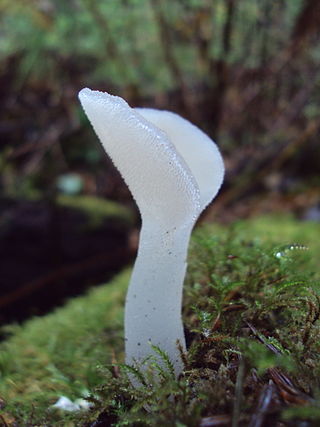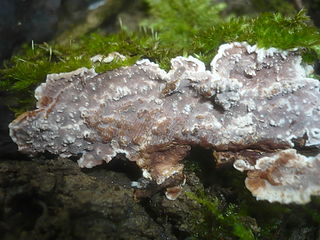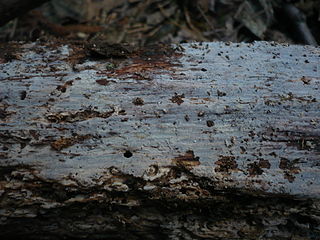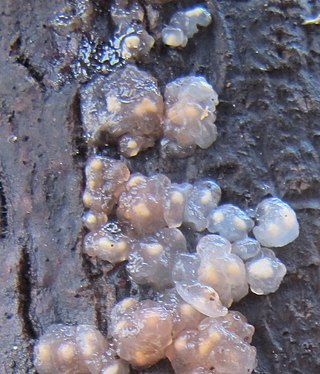
Pseudohydnum gelatinosum is a species of fungus in the order Auriculariales. It has the recommended English name of jelly tooth, a reference to its gelatinous consistency and hydnoid (toothed) undersurface. The species was thought to be cosmopolitan, but recent DNA evidence suggests that it is confined to Europe and northern Asia, with superficially-similar taxa elsewhere. A subspecies, Pseudohydnum gelatinosum ssp. pusillum, is found in North America. P. gelatinosum grows on dead conifer wood.

The Auriculariaceae are a family of fungi in the order Auriculariales. Species within the family were formerly referred to the "heterobasidiomycetes" or "jelly fungi", since many have gelatinous basidiocarps that produce spores on septate basidia. Around 100 species are known worldwide. All are believed to be saprotrophic, most growing on dead wood. Fruit bodies of several Auricularia species are cultivated for food on a commercial scale, especially in China.

Pseudohydnum is a genus of fungi in the order Auriculariales. Basidiocarps are typically bracket-like and gelatinous, with or without a stipe, with a hydnoid (toothed) undersurface. The genus is widely distributed in both the northern and southern hemisphere, with thirteen species currently described and others awaiting description.
Eichleriella is a genus of fungi in the order Auriculariales. Species produce effused or cupulate, waxy to leathery basidiocarps on wood, with a smooth to spiny surface. The genus contains some twelve species.
Heterochaete is a genus of fungi in the order Auriculariales. Species produce effused, gelatinous, waxy, or leathery basidiocarps on wood, partly or wholly covered in small sterile spines or pegs. The presence of these sterile spines distinguishes the genus from Exidiopsis, species of which are microscopically similar but have smooth basidiocarps.

Heteroradulum is a genus of fungi in the order Auriculariales. Species produce effused, leathery basidiocarps on wood, often pinkish red and partly or wholly covered in small sterile spines. The genus was originally published in 1917 by American mycologist Curtis Gates Lloyd under the facetious pseudonym "McGinty", rendering the name invalid. It was validated a century later to accommodate a group of species formerly placed in the genera Eichleriella or Heterochaete, but not closely related to either.
Protomerulius is a genus of fungi in the order Auriculariales. Basidiocarps are formed on dead wood and have an effused, smooth, spiny, or poroid hymenium. The genus is cosmopolitan.

Basidiodendron is a genus of fungi in the order Auriculariales. Basidiocarps are corticioid, thin, effused and are typically found on fallen wood. The genus is widespread in both temperate and tropical regions and contains over 30 species.
Aporpium is a genus of fungi in the order Auriculariales. Basidiocarps are formed on dead wood and have a poroid hymenium. Species were often formerly referred to the genera Elmerina or Protomerulius, but molecular research, based on cladistic analysis of DNA sequences, has shown that Aporpium is a distinct, mainly north temperate genus.

Elmerina is a genus of fungi in the order Auriculariales. Basidiocarps are formed on dead wood and are either bracket-like with a poroid hymenium or densely clavarioid. Species are known from East Asia and Australia.
Protohydnum is a genus of fungi in the order Auriculariales. Protohydnum cartilagineum, the type and only species, occurs in Central and South America and produces effused, cartilaginous basidiocarps on wood, yellow-ochre and wholly covered in small spines. Molecular research, based on cladistic analysis of DNA sequences, has shown that the genus is distinct, but that other species previously referred to Protohydnum belong in the genera Hyalodon or Elmerina.

Myxarium is a genus of fungi in the family Hyaloriaceae. Basidiocarps are gelatinous and effused or pustular. The genus is cosmopolitan. All species grow on dead wood or dead herbaceous stems.
Adustochaete is a genus of fungi in the family Auriculariaceae. Species produce effused basidiocarps on wood, typically covered in small sterile spines or pegs. The genus was created as a result of molecular research, based on cladistic analysis of DNA sequences, to accommodate two species from Brazil and Mexico that are not closely related to the older and superficially similar genus Heterochaete. Two additional species, from Brazil and China, have since been described.
Amphistereum is a genus of fungi in the family Auriculariaceae. Species produce cupulate to effused, leathery basidiocarps on wood. Microscopically, fruit bodies have a dimitic hyphal system. The genus is currently only known from North and South America.
Proterochaete is a genus of fungi in the family Auriculariaceae. The type and only species, Proterochaete adusta, produces thin, effused, corticioid basidiocarps with a smooth or spiny surface on wood. The species was originally described from North America and is also known from northern Europe and Asia.
Sclerotrema is a genus of fungi in the family Auriculariaceae. The type and only species, Sclerotrema griseobrunnea, produces effused, corticioid basidiocarps on wood with a smooth surface. The species was originally described from Russia and is also known from Canada.

Protodaedalea is a genus of fungi in the family Auriculariaceae. Species produce bracket-like basidiocarps on wood with a lamellate (gilled) undersurface. The genus currently comprises two species, both known from Asia.
Hyalodon is a genus of fungi in the order Auriculariales. Species occur on dead wood in Europe and Asia, producing effused, gelatininous basidiocarps covered in small spines. Molecular research, based on cladistic analysis of DNA sequences, has shown that the genus is distinct.
Mycostilla is a genus of fungi in the order Auriculariales. The type and only species, Mycostilla vermiformis, forms effused, gelatinous, crystalline or net-like basidiocarps on fallen conifer wood in Europe. The species was formerly placed in Stypella, but the latter genus is of uncertain disposition and appears unrelated to the Auriculariales. Molecular research, based on cladistic analysis of DNA sequences, distinguishes Mycostilla from the morphologically similar genus Stypellopsis.
Stypellopsis is a genus of fungi in the order Auriculariales. Basidiocarps are effused, gelatinous, crystalline or net-like and occur on fallen conifer wood. Species were formerly placed in Stypella or Protomerulius, but molecular research, based on cladistic analysis of DNA sequences, distinguishes Stypellopsis from these genera and from the morphologically similar genus Mycostilla. The type species occurs in northern Europe, Stypellopsis farlowii in North America.







